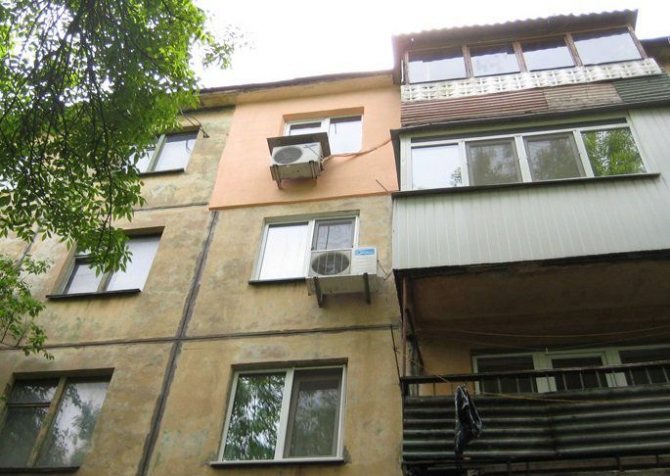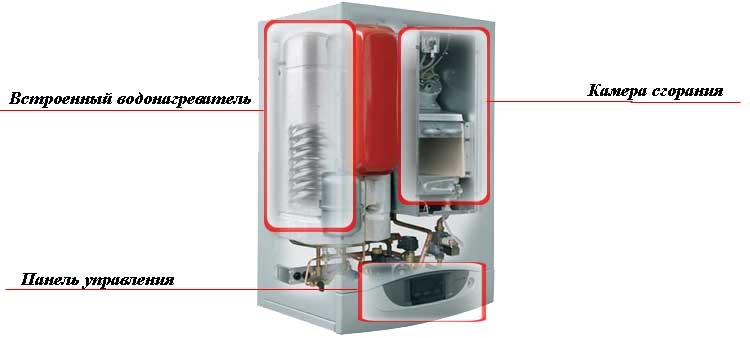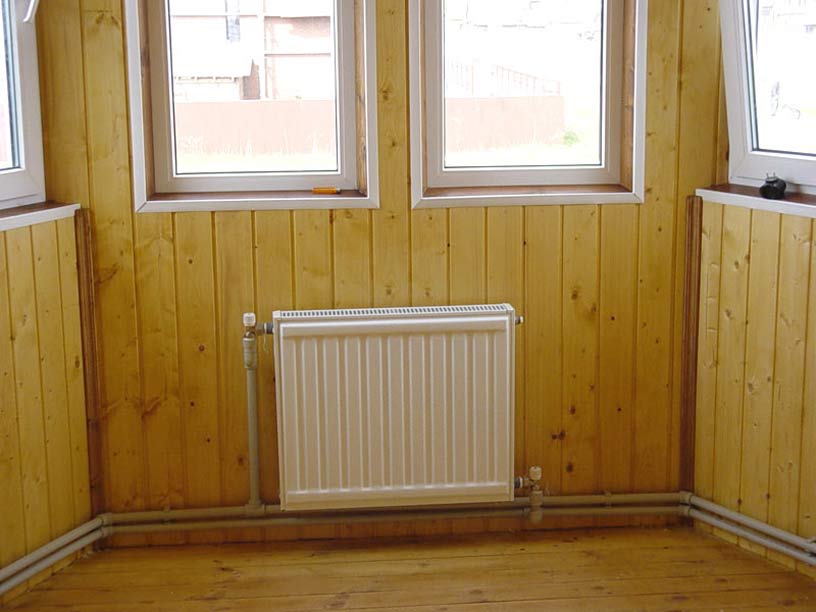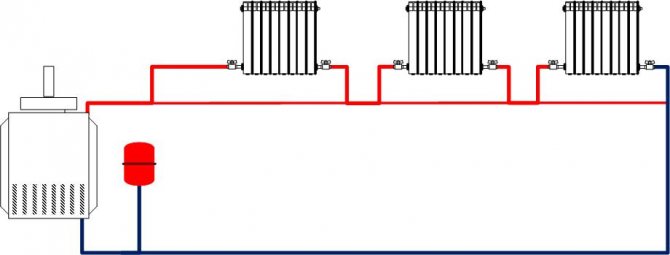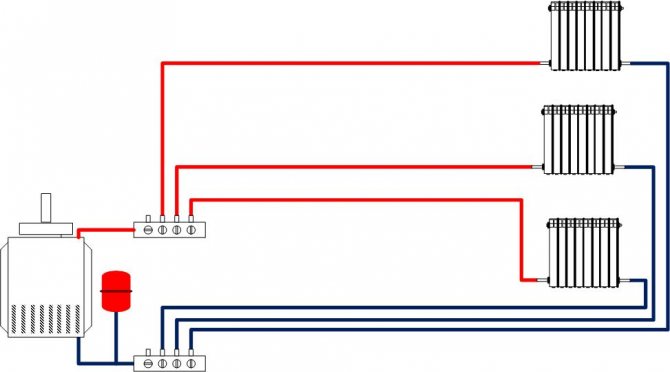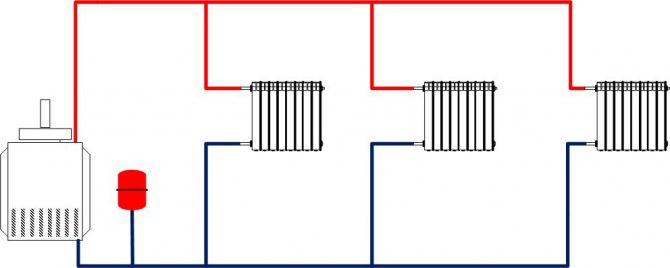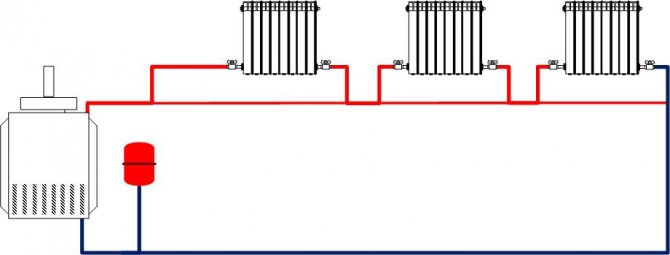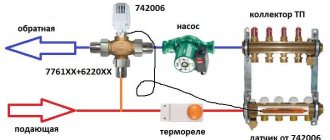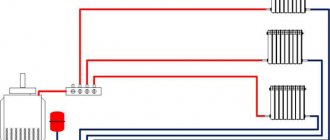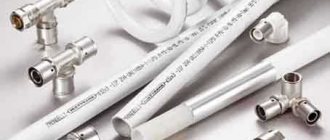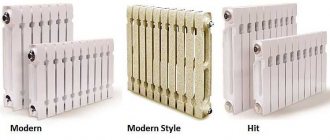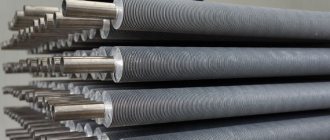Hot water supply in heating systems
Residents of Khrushchev can solve the problem of inefficient heating by installing modern radiators and pipelines in the apartment. To understand how to choose the right heating batteries for an apartment, it is important to study the performance characteristics of heating devices made of different metals. It is most rational to replace heating devices in all apartments connected to the same riser.
One-pipe heating systems for apartment buildings, due to their economy, have many disadvantages, and the main one is a large heat loss along the way.
The heating device in a nine-story building is made according to a completely different principle. The supply line, bypassing the apartments, is immediately carried out to the upper technical floor. An expansion tank, an air relief valve and a valve system are also based here, which allows you to cut off the entire riser if necessary. In particular, the temperature in winter will be at the level of 20-22 degrees, and the relative humidity will be about 40%. To achieve such indicators, not only the basic heating scheme is important, but also the high-quality insulation of apartments, which prevents heat from escaping to the street through cracks in the walls, roof and window openings.
This is one of the best mechanisms for raising the temperature in an apartment. It can be installed not only in the bathroom and kitchen, but also in living quarters. It is best to choose infrared floor heating models, since their installation requires a minimum increase in the thickness of the floor covering. The heating circuit of the Khrushchev is not designed for connecting a water-heated floor.
But in order for the efficiency of central heating to be at the proper level, the heating scheme in an apartment building is drawn up by professionals in their field - heating engineers. The fundamental principles by which a house heating scheme is designed are to achieve maximum heating efficiency with a minimum waste of resources.
And it is especially noticeable on reinforced concrete floors. On the lower side of the floor there is a residential apartment, and on the other side of the floor there is outdoor cold. Can you imagine what a huge heat flux passes through the wet ceiling over the entire living area if the ceiling is not well insulated?
The lion's share of the modern housing stock in large cities falls on multi-storey buildings, built during the Soviet Union. In those days, the issue of saving heat was not so acute, and residential buildings were heated through a centralized system.
What is a standard mixing unit
A standard mixing unit, or CMS, is a standardized version of a technical solution for the reconstruction of heating units in buildings. Its main function is to provide the required parameters of the coolant to maintain them at the required level without overheating and underheating.
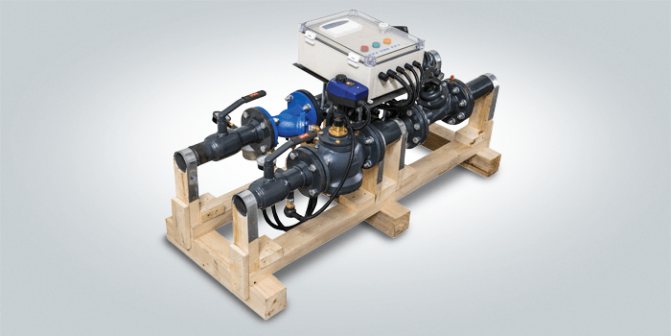
Standard mixing unit
A standard mixing unit connects the heating systems of a residential building to the heating network, controls the supply of heat carrier to the building and creates the heat consumption mode necessary for the building. In addition to ensuring the efficient operation of the heating system and eliminating the drawbacks of elevator units, SUS allows further modernization of internal heating systems (balancing risers, installing radiator thermostats on heating radiators), increasing the level of comfort for residents.
A standard mixing unit includes all the elements necessary to regulate and create a hydraulic mode of the heating system, it is a completely finished product, easy to install and maintain.
Centralized heating scheme for Khrushchev
The installation of new heating devices on all floors will result in a round sum, but such measures will give tangible results instantly.
Repair work with heating with water draining even from one riser in cold weather is very fraught with scandals with neighbors and even the formation of not only air, but also ice plugs in the heating system in the basement and entrance.
Materials with a large dependence of thermal insulation properties on absolute humidity include: concrete, cement screeds, expanded clay, red brick, sand-lime brick, wood, foam concrete, various gypsum-cement-sawdust-slag materials - almost everything that is not foam and polyurethane foams closed cell.
But when the pressure exceeds the norm, it is simply dumped into the expansion tank, and when the coolant cools, as a result of the column pressure, it returns back to the circuit. Such containers in private houses, as a rule, are installed in the attic.
Heating circuits defined by piping
The difference between these heating systems lies in the principles of connecting heating devices to the boiler. It can be a serial or one-pipe connection, parallel or two-pipe and beam, it is also a collector.
Sequential heating system
In a heating system with one pipe, the hot coolant enters all the heating devices in order, in each it gives off part of the heat. Such wiring diagrams of heating systems are the simplest, and the least components and materials are spent on its implementation.
The main disadvantage of such a system is that the amount of heat emitted decreases depending on the increase in the distance from the boiler.
Heating circuit with two pipes
In this heating system, two pipes are suitable for each heating device - with a hot coolant, a direct one, and already with a cold one, a return one. The system has undoubted advantages, but they are "paid" for with a double set of pipes laid in the house.
Radiant heating system
This system differs from the others in that a separate pair of pipes is laid to each heating device - both direct and return flow. They then converge near the boiler on special combs. The total pipe length is longer than in a two pipe system.
No connections are made in these pipes and balancing is carried out before putting it into operation. That is, the flow rate of the coolant is adjusted for each loop separately.
Such a system solves the issues related to the regulation of heat transfer for each heater in a system with one pipe. Each battery has shut-off valves and with its help the flow rate of the coolant through it is regulated.
In addition, a shunt is made in the form of a bypass pipe having a smaller diameter. This shunt allows fluid to circulate even if the battery taps are completely closed.
Types of connections to heating systems
The main function of the unit is to directly participate in the heat exchange process, since the hot coolant, getting into it, is dosed and mixed with the injected coolant from the return. As a result, the unit allows you to achieve optimal results in matters of mixing the hot coolant from the boiler room and cooled water from the return.
This can lead to a decrease in pressure in the pipes and significant heat loss for residents below. In order to avoid unpleasant moments, you can perform a number of actions that contribute to energy saving in the apartment.
The main thing is that the house does not keep warm if the inside of the apartments is damp. About plastic windows. How much does central heating cost if a damp, cold apartment is a heat meter?
The negative point is that the heating scheme of the five-story Khrushchev house does not provide for the connection of additional radiators.
The radiator batteries are installed in series, without a "main" riser - see the heating diagram below - this is the case.
The implementation of such modernization can be carried out not only by the forces of residents, but also by attracting the resources of the housing office. This organization is obliged to carry out a planned replacement of pipelines. They also know how the heating system in Khrushchev works - the layout and location of pipelines for a particular house.
First, let's pay attention to the local or autonomous heating system, used mostly in the private sector and in rare cases (as an exception) in multi-storey buildings. In such cases, the boiler room is located directly in the building itself or near it, which allows correct adjustment of the coolant temperature.
In addition to the boiler, the existing circuit will have to be re-equipped. Heating batteries used and new radiators can be connected to it, which are tied with a pipeline in accordance with the heating scheme. Depending on the required heat output, low radiators installed under the windowsill, as well as standard radiators, can be used in the heating circuit.
Important: some residents of the outer floors are trying to move the air relief valve to the attic, so as not to collide with housing and communal services workers every season.
This is due to the alternate passage of the coolant through the floors, i.e. the greatest degree of its heating will be at the 5th, 4th, and at the 1st, the amount of heat is not enough to heat the room. In addition, the heating scheme of the five-story Khrushchev has the following disadvantages:
- Poor condition of heating elements. Lime build-up on the inner surface of pipes and batteries leads to a decrease in diameter, and as a result, a decrease in heat transfer;
- Lack of temperature control system on batteries. It is impossible to reduce the flow of coolant with devices, as this will affect the hydraulic pressure in the entire system. Output - bypass installation for each radiator.
How to properly start the heating system of 5 and 9 storey buildings
How to properly start the heating systems of 5 and 9 storey buildings?
There is no fundamental difference in starting the heating system of five and nine-storey buildings from multi-storey high-rises.
The basic principles in all buildings, regardless of the number of storeys, are the same - they are slow filling of the system and the release of air. We wrote about the order and errors in starting up heat in multi-storey buildings in a separate article.
It is not always possible to control the start-up of heat with heat supply organizations such as MOEK and the heating network. Often, the CHP operator, in order to report to the management about the launch of more houses, is in a hurry or unknowingly turns on the make-up pump in the CHP at maximum speed, the system is guaranteed to draw air.
It is also possible due to poor contact between the operating composition of housing and communal services with the operators of the central heating station.
But in one case or another, the consequences of a "quick" start-up of heat are the same, the house picks up air when it starts up, and since air is lighter than water, it rises and blocks the upper floors, forming air locks.
It got its name "airlock" due to the fact that, forming on the upper floors, it completely blocks the circulation of the coolant through the heating device and, as a result, the "airborne" radiator remains completely or partially cold.
The main task of the operating organization is, if air has already entered the system, to release it on time and correctly.
Five-story houses are available with or without attics. In houses with attics, heating systems are performed with upper wiring, which means that the supply main pipelines are laid in the attic, and air collectors are installed there.
Air collectors are an element of the heating system, which is a pipe of a much larger diameter, installed on the supply lines at the highest point of the system, on which a drain valve is installed.
In order for the locksmith not to run into each apartment on the last floor, all the accumulated air is drained from the air collector in the attic.
To do this, open the drain cock, through which all the accumulated air begins to escape with a whistle.
But this simple procedure must be monitored, because lack of proper attention to the air release process can lead to flooding of the upper floors.
After the air leaves the drain valve, an air-water mixture begins to come out, so you need to substitute a container under the tap or attach a hose and drain the remaining air-water mixture into the sewer until water without air impurities flows.
But there are five-story buildings without attics, and then you have to release the air in each radiator on the fifth floor.
After bleeding air from the heating system, all risers and radiators begin to completely warm up right before our eyes.
rssrv.ru
Features of heating an apartment in a multi-storey building
The implementation of such modernization can be carried out not only by the forces of residents, but also by attracting the resources of the housing office. This organization is obliged to carry out a planned replacement of pipelines. They also know how the heating system is arranged in Khrushchev - the layout and location of pipelines for a particular house.
Pipes above windows or under the ceiling spoil the appearance of the premises. In addition, some of the heat is lost through the ceiling. Therefore, there is a scheme with a supply pipe under the radiators.
For such a circuit to function properly, the expansion tank must be above the horizontal coolant supply pipe in order to create columnar pressure. That is, hot water from the boiler enters the circuit during expansion.
When air pockets form in these places, the pipes are subject to corrosion, since natural pressure is not able to push the air.
Installation of a bulkhead (bypass) and ball valves
The sections of the hot water pipe, into which the heated towel rail will be connected, must be connected with a jumper. The need for this complicating element is obvious:
It is better to make the supply to the bypass from stainless steel pipes.
- in the event of a malfunction in the operation of the coil, you will not need to visit the ZhEK to apply for a new shutdown of the water;
- it is not necessary to carry out work on the installation and connection of a heated towel rail strictly within the specified period for which the water was turned off.
This is especially true for those who are waiting for the replacement of a heated towel rail in the "Khrushchev" on their own and without sufficient experience.
How does the bypass work (Fig. 1)? If it becomes necessary to turn off the heated towel rail later for repair, it is enough to turn off the ball valves at the inlet and outlet of the water flow from the coil. At the same time, a faucet on the jumper that is open will allow you not to deprive your neighbors of hot water while the coil is being replaced or repaired.
What you need to install a bypass:
- three ball valves;
- pipe sections of the required length;
- connecting elements: tees with a diameter corresponding to the diameter of the pipeline, 2 pcs .;
- Adjustable wrench.
- At the ends of the pipe leading to the hot water supply system, install tees so that between them it is possible to lay a piece of pipe connecting the water flow in them.
- Connect two short pipe sections with a ball valve and install this structure between the branches of the tees. Seal threaded joints with FUM tape or linen winding. Open the tap.
- Install ball valves on the remaining free ends of the tees, to which the heated towel rail will subsequently be connected. Move the valves to the "closed" position.
Related article: Projects of a bath with a gazebo and barbecue - design features
With this position of the three taps, the water will pass through the jumper without entering the heated towel rail coil.
Heat supply of a multi-storey building
What to do if, even after performing the improvement and replacing the elements, the temperature in the apartment is far from ideal. The best option is autonomous heating in Khrushchev. However, this is not always possible - the installation of a gas boiler is not allowed due to low pressure in the line or due to inappropriate chimney ducts.
In order to understand how much heat carrier you use to heat a house with a large number of apartments, the best option would be to install a house meter. To calculate the payment for the consumed heat, readings are taken from the meter. They are divided by the number of apartments in the building and by their area.
A well-designed heating system for an apartment building, a scheme for which is developed individually, guarantees that optimal conditions will be maintained inside the apartments.
Special attention should be paid to windows in apartments and balconies. It is recommended to install meters in each apartment and install taps to regulate the temperature of the consumed energy carrier.
Alternative heating methods in Khrushchev
It should be borne in mind that it is not so easy to make autonomous heating. The owner of an apartment in Khrushchev needs to obtain many permits and this option for optimizing the heating system is not always realistic. Residents of Khrushchevs are denied permits for individual heating due to low main pressure in the circuit, inconsistency of chimney ducts with required standards, violation of fire safety standards, etc.
In such cases, it is recommended to use alternative methods:
- use additional electric heaters;
- install a warm floor;
- insulate external walls and windows, etc.
When choosing to use additional heating devices powered by electricity in Khrushchev, you should make sure that the wiring will withstand high loads.
Using the recommendations given in the review, the owner of an apartment in a five-story Khrushchev will be able to optimize the heating system and achieve comfortable temperature conditions in his home. Do not forget about the periodic maintenance of the heating system, which must be carried out from time to time. It will help prolong the life of the heating devices installed in the apartment and maintain the achieved heat transfer rates.
Heating system in Khrushchev: diagrams, heating device for a five-story building
In residential buildings, for a comfortable stay, high-quality communications are needed, including those intended for heating. They are divided into two large groups - one-pipe and two-pipe. The former are much simpler and cheaper. Hot water is supplied and discharged through one pipeline to all heating devices connected in series to the system.
The supply is ringed on the last radiator, where it can switch to return either with the same pipe or through the battery, which practically does not make any difference - it just depends on the ease of installation.
It is no secret that losses during transportation can reach up to 30% and we have to pay for all this. Avoiding central heating in an apartment building is a tricky and troublesome process, but first, let's figure out how it works.
The essence of the operation of a two-pipe heating circuit is as follows:
- the coolant from the heater enters the supply pipe;
- where it is alternately distributed through the radiators;
- and after the liquid passes through the sections of the device, it enters the return pipe, through which it is fed back to the boiler.
Material for connecting pipes
When creating heating, pipes are used, for the manufacture of which various materials are used.
Pipes can be simply steel, galvanized, stainless steel, copper, polymer, including metal-plastic, polyethylene, polypropylene reinforced with aluminum.
- Iron has a significant drawback - poor corrosion resistance... Pipes made of stainless steel or galvanized on the contrary, do not corrode, they are installed using threaded connections. The installation of such a pipeline requires certain qualifications and work experience. Nowadays, when there are metal-plastic and polypropylene on the market, steel is practically not used.


Iron pipes for heating
- Copper pipes - their advantage is the ability to withstand high temperatures and high pressure, durability and reliability... The connection of copper pipes is carried out using high-temperature brazing, a solder that contains silver. Highways are masked in the walls during finishing work. Working with them requires a very high level of professionalism. Copper pipes are most often used in construction of an exclusive nature, because they have a very high price.
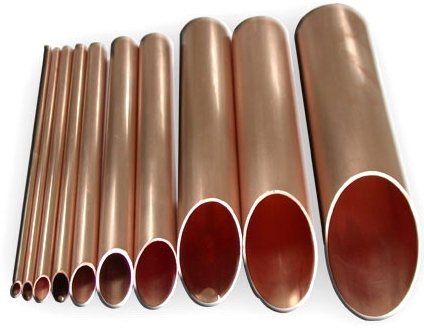

Copper for heating
- Polymer pipes - the material for them is polyethylene or polypropylene... Very comfortable and easy to install. Such pipes are durable, corrosion-resistant, they have a smooth inner surface that excludes the deposition of mineral salts.
Polypropylene for heating
- Metal-plastic - consists of two layers of plastic, separated by a layer of aluminum.
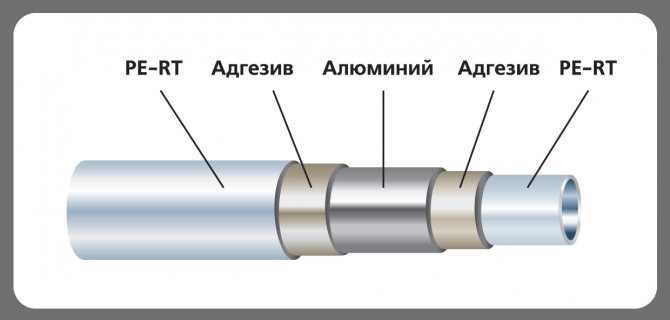

Metal-plastic for heating
Installation of metal-plastic is carried out using threaded connections, while welding is not used. Press connections can also be used, as a result of which the cost of installation is significantly reduced.
The disadvantage of such pipes for heating is that they have a large coefficient of thermal expansion. Simply put, if cold water is connected immediately after hot water, the connections may begin to leak.
Attention: It is highly undesirable even to temporarily stop the operation of the boiler during the heating period and to defrost the heating. Due to a sufficiently strong change in the linear dimensions, the pipeline may be damaged at the joints.
Another reason for the appearance of a leak, perhaps, is the bend of the pipe at a decent angle, be it straight or even more acute. This is because the aluminum layer may crack.
Features of heat supply for multi-storey buildings
Such a heating system in a five-story building or in a building with fewer or more floors allows heating at certain times of the year and paying bills for the actual energy consumption. Such a heating system for Khrushchev implies that a meter is installed to control the heat, from which monthly readings are taken.
There are a lot of nuances that need to be observed, and there is no guarantee that your home will be released from control by the local authorities.
The centralized heating system in Khrushchev is implemented using a single-pipe piping of radiators. According to the scheme, the coolant spreads along the contour, starting from the fifth floor. As it passes through the system, the cooled coolant enters the basement (basement).
Then they begin to develop alternative ways to increase the temperature in the room. The negative point is that the heating scheme of the five-story Khrushchev house does not provide for the connection of additional radiators. This can lead to a decrease in pressure in the pipes and significant heat loss for residents below.
Ventilation options
Ventilation in Khrushchev can be done in two versions. In the first case, when there are vertical shafts that go directly to the roof of the building.In this case, each apartment has its own individual ventilation duct. You can verify this if you go to the roof of the house and calculate how many exits the ventilation shaft has.
As a rule, in each apartment there should be at least two of them - from the kitchen and the bathroom. If the bathroom and the bathroom are separated, then they are connected at the top with a simple hole. One of them has a ventilation outlet. From another room, where there is no such exit, air comes out through this very hole.
Another option is satellites ventilation ducts arranged across the floor. This is a series of channels that run from the first floor to the very exit to the roof. To them at a height of 2.5 m, i.e. through the next floor, a branch is made from each apartment, which is included in a common shaft.
On the way, air from any apartment should not enter the channels of other apartments, which must be closed with special plugs. But during the construction of the Khrushchev houses, this was not always done, since the first task at that time was to quickly provide the people with comfortable housing. As a result, today we have such “pleasant moments” when the smell of tobacco or fried fish from one kitchen penetrates into many apartments at once.
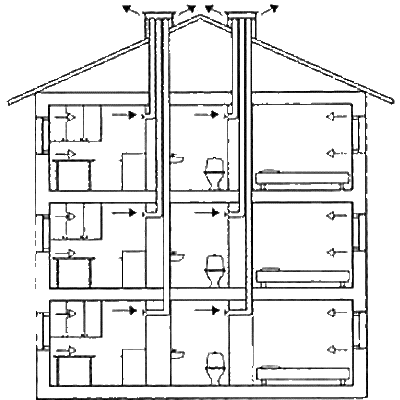

Other reasons affecting ventilation efficiency
Now that it is clear how the ventilation is arranged in the Khrushchev, we can consider various reasons why the air from the living quarters is not taken out. Most often, with the advent of modern kitchen furniture, where the hood is mandatory, residents make its output to the ventilation duct, which is located in the kitchen, and the hood does not turn on often, and at the same time the second channel is occupied by a gas water heater.
As a result, it turns out that there is practically no ventilation in the apartment, and odors from the bathroom or bathroom may appear. This is due to the fact that the kitchen hood and gas water heater, creating a rarefied atmosphere near them, take air from the living quarters according to the principle of a vacuum cleaner, and the air from the toilet also tends to the exhaust hole.
There are times when the tenants themselves or their predecessors simply tightly close the ventilation hole with decorative elements, motivating this with its unpresentable appearance, or by the fact that various insects get into the apartment from such holes.
Such people should remember that the ventilation scheme in Khrushchev provides for only two channels, one of which should be located in the bathroom, and if you close the one in the kitchen, you will have to keep the toilet door constantly open.
The reason for the poor performance of ventilation can also be the fact that there are flaws in the sealing of joints during the installation of ventilation blocks, if the building was built from ready-made reinforced concrete panels. Through leaky joints, odors from one apartment can freely penetrate into others.


Also, a common reason is the common debris of the ventilation shafts. But this should already be the concern of the organizations serving the house.
Installation of a heating system in an apartment building
As the name implies, the bottom-filling distribution scheme provides for the supply of the heating medium from the bottom up. The classic heating of a 5-storey building is assembled according to this principle.
Such a system works on the principle of deaeration or automatic regulation of the maintained pressure using a special, hermetically sealed expansion tank. Such a container consists of two sectors, separated by a heat-resistant rubber membrane.
The disadvantages include:
- many pipes and fittings;
- rather complicated installation;
- higher cost than a single pipe system.
Closed
Operating principle
Note.Closed heating systems are dependent, so the circulation of the coolant is possible here only with the help of a circulation pump that runs on electricity, therefore, depends on an external energy source (power line, diesel or carburetor electric generator).
Closed heating system diagram
Closed systems in most cases operate on gas, electric, diesel and solid fuel heating boilers and are directly dependent on electricity. Regardless of what fuel the boiler itself runs on, the circulation pump operates exclusively with electricity.
Nevertheless, such systems have gained universal approval and popularity due to their high efficiency and reliability, as well as the automatic control method - in emergency situations on power lines, a diesel or carburetor generator can become a source of electricity.
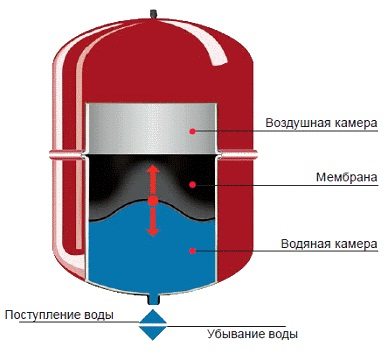

Closed expansion tank
Such a system works on the principle of deaeration or automatic regulation of the maintained pressure using a special, hermetically sealed expansion tank. Such a container consists of two sectors, separated by a heat-resistant rubber membrane.
One compartment contains air or nitrogen (if the injection was carried out by the manufacturer), and the second compartment, through the safety valve, enters the coolant if its pressure exceeds a predetermined threshold. When the coolant cools down, the pressure in the system drops and the gas squeezes out the liquid accumulated there from the reservoir back into the circuit.
Benefits
- The expansion tank in such systems can be installed anywhere (above, at or below the heating circuit) - in any case, an electric pump is responsible for the circulation of the liquid.
- No need to control the volume of the coolant in the system (automatically controlled).
- Antifreeze can be used to eliminate the possibility of defrosting the system.
- To heat the circuit, you can use backup boilers, for example, in addition to the main gas boiler, install a solid fuel or electric unit. Also, all these heaters can work together as a group.
- All system parameters are adjusted automatically, therefore, it can be left unattended for a long period by setting the mode you need.
disadvantages
- Such systems have a higher cost of installation and equipment.
- Dependence on electricity.
How to pay for heating at the current time?
There are three types of schemes that allow you to choose the most acceptable option for paying for heat:
Country house heating systems
- year-round payment. A certain tariff is established, the payment for which is divided into 12 months in equal parts. Often, with this type of payment, the amount of the monthly payment is lower than with a 6-month payment;
- payment by home meter. Here the monthly payment is calculated based on the consumed volume of the energy carrier divided by the occupied area;
- payment by personal meter.


Payment for heating by the meter
